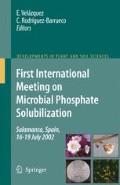Abstract
For over one hundred years, agricultural microbiologists and soil ecologists have studied the ability of a wide range of soil microorganisms to dissolve poorly soluble mineral phosphates. In the case of calcium phosphates, a significant body of evidence has been developed to show that Gram negative bacteria exhibiting superior mineral phosphate solubilizing (MPS) capabilities utilize the direct oxidase pathway. This pathway (also called nonphosphorylating oxidation) produces gluconic acid and 2-ketogluconic acid directly in the periplasmic space. These strong organic acids can dissolve poorly soluble calcium phosphates such as hydroxyapatite and rock phosphate ore (e.g. fluroapatite). Therefore, we propose that the conservation of the direct oxidation pathway in rhizobacteria may, at least in part, result from the mutualistic advantage provided by the MPS trait. This article contains a brief literature review, some examples of ongoing work in our lab and, finally, a proposal for a unified terminology for the classification of microorganisms capable of solubilizing or mobilizing P in the soil or other ecosystems.
Access this chapter
Tax calculation will be finalised at checkout
Purchases are for personal use only
Preview
Unable to display preview. Download preview PDF.
References
Agnihotri V P 1970 Solubilization of insoluble phosphates by some soil fungi isolated from nursery seed beds. Can. J. Microbiol. 16, 877–880.
Asea P., Kucy R M N and Stewart J W B 1988 Inorganic phosphate solubilization by two Penicillium species in solution culture and soil. Soil. Biol. Biochem. 20, 459–464.
Babu-Khan S, Yeo T C, Martin W L, Duron M D, Rogers R D and Goldstein A H 1995 Cloning of a mineral phosphate solubilizing gene from Pseudomonas cepacia. Appl. Env. Microbiol. 61, 972–978.
Bagyaraj D J, Krishnaraj P U and Khanuja S P S 2000 Mineral phosphate solubilization: agronomic implications, mechanism and molecular genetics. Proc Indian Nat. Sci. Acad. (PINSA) 66, 69–82.
Banik S and Dey B K 1982 Available phosphate content of an alluvial soil as influenced by inoculation of some isolated phosphate solubilizing microorganisms. Plant Soil 69, 353–364.
Duine J A 1991 Quinoproteins: enzymes containing the quinoid ofactor pyrroloquinoline quinone, topaquinone or tryptophan-tryptophan quinone. Eur. J. Biochem. 200, 271–284.
Gerretsen F C 1948 The influence of microorganisms on the phosphate intake by the plant. Plant Soil 1, 51–81.
Goldstein A H 1986 Bacterial mineral phosphate solubilization: Historical perspective and future prospects. Am. J. Altern. Agric. 1, 57–65.
Goldstein A H and Liu S T 1987 Molecular cloning and regulation of a mineral phosphate solubilizing gene from Erwinia herbicola. Bio/Technology 5, 72–74.
Goldstein A H, Rogers R D and Mead G 1993 Separating phosphate from ores via bioprocessing. Bio/Technology 11, 1250–1254.
Goldstein A H 1994 Involvement of the quinoprotein glucose dehydrogenase in the solubilization of exogenous phosphates by gram negative bacteria. In Phosphate in microorganisms: cellular and molecular biology. Eds. A Torriani-Gorini, E Yagil and S Silver. pp. 197–203. ASM Press, Washington, D.C.
Goldstein A H 1995 Recent progress in understanding the molecular genetics and biochemistry of calcium phosphate solubilization by gram negative bacteria. Biol. Agric. Horticult. 12, 185–193.
Goldstein A H, Braverman K E and Osorio N 1999 Evidence for mutualism between a plant growing in a phosphate-limited desert environment and a mineral phosphate solubilizing (MPS) rhizobacteria. FEMS Microbiol. Ecol. 30, 295–300.
Goldstein AH 2000 Bioprocessing of rock phosphate ore: essential technical considerations for the development of a successful commercial technology. Proceedings of the 4th International Fertilizer Association Technical Conference. IFA, Paris.
Hausenbuiller R L 1972 Soil Science, Principles and Practices. Wm. C. Brown Company, Dubuque, Iowa, 269 p.
Illmer P and Schinner F 1992 Solubilization of inorganic phosphates by microorganisms isolated from forest soils. Soil Biol. Biochem. 24, 389–395.
Kucey R W N, Tanzen H H and Leggett M E 1989 Microbially mediated increases in plant available phosphorus. Adv. Agron. 42, 199–228.
Liu S-T, Lee L-Y, Tai C-Y, Horng C-H, Chang Y-S, Wolfram J H, Rogers R D and Goldstein A H 1992 Cloning of an Erwinia herbicola gene necessary for gluconic acid production and enhanced mineral phosphate solubilization in Escherichia coli HB101. J. Bacteriol. 174, 5814–5819.
Richardson A E 1994 Soil microoganisms and phosphorus availability. Soil Biota 50, 35–39.
Sperber J I 1957 Solution of mineral phosphates by soil bacteria. Nature. 180, 994–995.
Sundara Rao W B and Sinha M K 1963 Phosphate dissolving microorganisms in the soil and rhizosphere. Indian J. Agric. Sci. 33, 272–278.
Tinker P B 1980 The role of rhizosphere microorganisms in phosphorus uptake by plants. In The role of rhizosphere microorganism in phosphorus uptake by plants. Eds. Khasawneh F E, et al. pp. 617–647. American Society for Agronomy Press, Madison.
Author information
Authors and Affiliations
Editor information
Rights and permissions
Copyright information
© 2007 Springer
About this paper
Cite this paper
Goldstein, A.H. (2007). Future trends in research on microbial phosphate solubilization: one hundred years of insolubility. In: Velázquez, E., Rodríguez-Barrueco, C. (eds) First International Meeting on Microbial Phosphate Solubilization. Developments in Plant and Soil Sciences, vol 102. Springer, Dordrecht. https://doi.org/10.1007/978-1-4020-5765-6_11
Download citation
DOI: https://doi.org/10.1007/978-1-4020-5765-6_11
Received:
Accepted:
Publisher Name: Springer, Dordrecht
Print ISBN: 978-1-4020-4019-1
Online ISBN: 978-1-4020-5765-6
eBook Packages: Biomedical and Life SciencesBiomedical and Life Sciences (R0)

